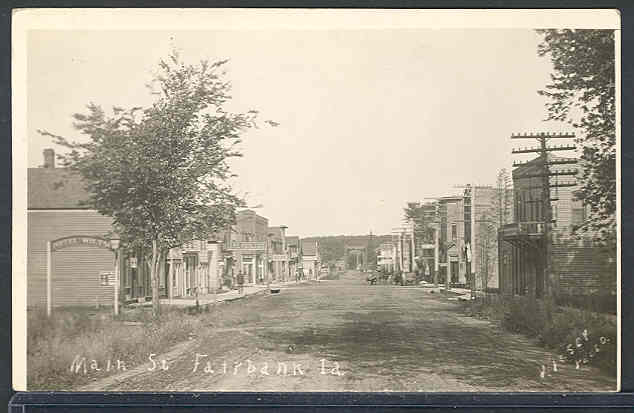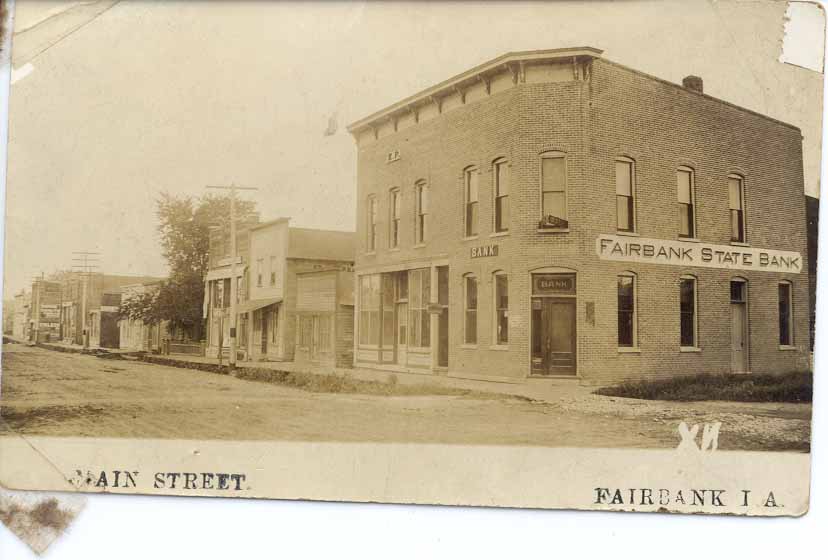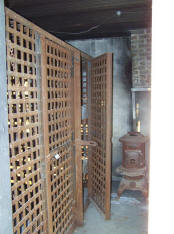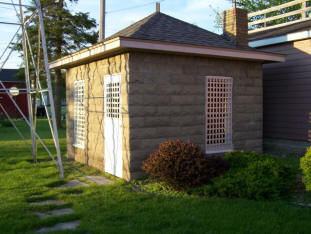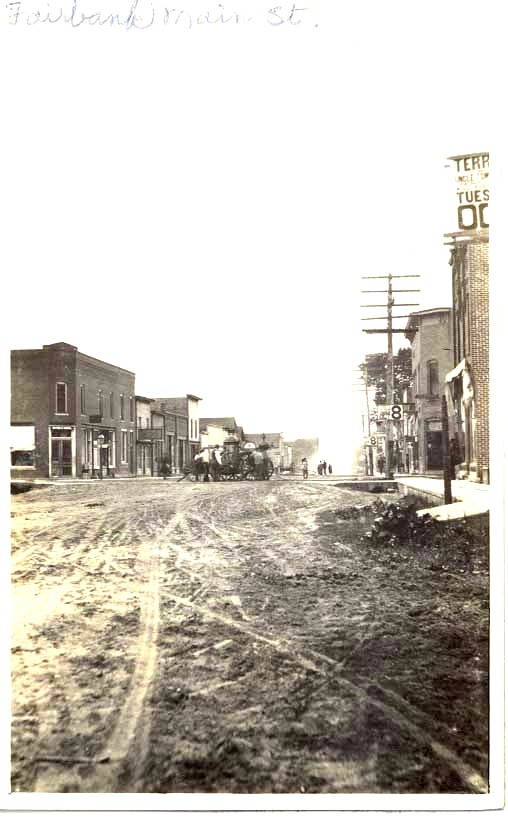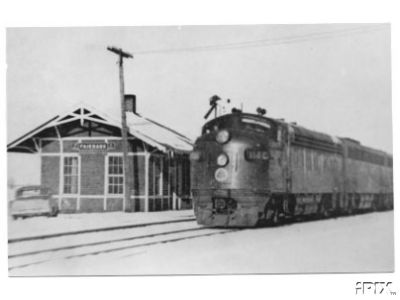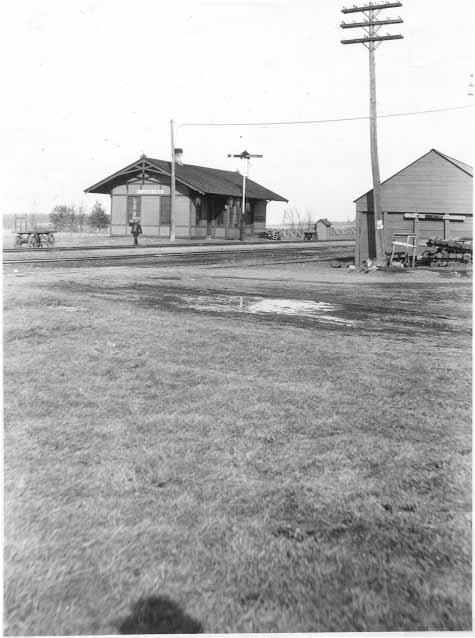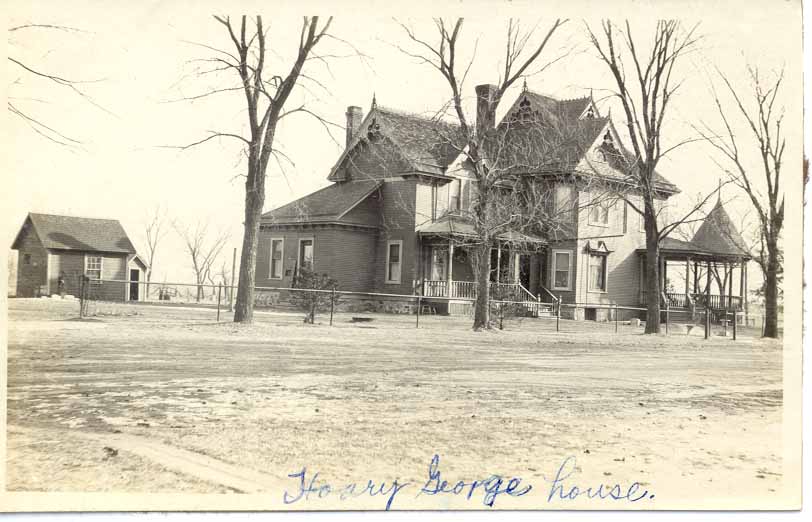 |
HOME
|
 |
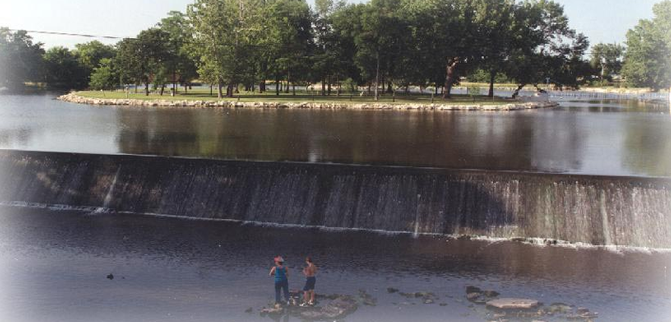
Our Departments |
|
Police Department |
|
Event Calendar |
|
City Newsletters |
|
Fairbank GIS Maps |
|
Living in Fairbank, Iowa
Village
In 1854 a village was laid out in the north part of the township by F. J. Everett and C. W. Bacon, and called Fairbank.
Afterwards an addition was made thereto by Frederick Patterson, and called Patterson's addition. The first store kept here was by John McCuniff, in 1855, and the building in which he kept it was made of oak lumber procured at Everett & Bacon's mill, mentioned above.
The present business men of the place are as follows:
Physicians, J. A. Ward, E. D. Wiltsie, W. G. Dwyer, and G. B. Ward; drug stores, A. R. Wolgomot, J. A. Ward, and F. J. Everett; flouring mill, situated on the Little Wapsie, that passes through the village, owned by Minkler & Nichols, and operated by W. H. Miller; hardware, C. E. Redfield; general stores, Minkler & Nichols, J. C. Myers, H. Higby, and F. J. Everett, the pioneer; shoe shop, Ernest Martin; shoe store, L. D. Lowell; grocery, B. F. Raney; cooper shop, Barnard McGuire; postmaster, H. Higby; carpenters and wagon makers, George DeLong and John Ball; hotels, Grove house, by Jacob Myers, and one by A. Chase; millinery store, Misses Keith & Parris; blacksmiths, C. R. Ward, a Mr. Parsons, and A. J. Ward; harness shop, B. F. Stevens; egg and butter packing house, J. W. Redfield.
A fine public school-house on the west side of the river, employing two teachers.
Houses of Worship-Catholic, Methodist Episcopal, Free Will Baptist, and German Lutheran.
Post Office and Mail Route
The first office was established here in 1854, and C. W. Bacon appointed postmaster, who kept it in the little log cabin built by him and Everett. Fred Patterson was the first mail carrier, going once a week to Independence. In 1866 an office was established in the southern part of the township, called Kier, and James M. Walker was appointed the first postmaster; E. L. Hopkins is the present incumbent. They now have a tri-weekly mail from the village of Fairbank to Independence, and one twice a week from Waverly, Bremer county, by way of Oelwein.
Fairbank Township
This township is located in the northwestern part of the county. It was, at the time of its organization, called Alton, but, about one year after, the name was changed to Fairbank. In the meantime, a village had been located in the north also called Fairbank, and a post office of the same name. One of the founders of the village was a Mr. Bacon, whose grandmother's name was Fairbank. He suggested the name to his partner, F. J. Everett, to which all agreed; hence the name.
Organization
It was organized as a separate and independent township March 5, 1855, as evidenced by the county court record, which is as follows:
State of Iowa, Buchanen County, S. S. March 5, 1555: it is ordered by the court that township ninety, north, of range ten, west, be detached from Perry township, and that it shall hereafter be and form a separate township, to be called Alton, and that an election be holden in said township on the first Monday in April next, at the house of George Beatty, in said township, and that George Beatty, Miles Soper and Sampson George be the judges of said election. The court further orders that the west tier of sections in township ninety, range nine, be detached from Perry township, and hereafter form a part of Superior township.
About one year after the above order was made the name of the township was changed to Fairbank, and the name Superior has been changed to Hazleton.
F.F.D. Then & Now (Fire Department)
The first Fire Department building was located on a lot between what is now Don's Truck Sales and the river. In the early 1900's this building was moved to city property where the water tower now stands. The original fire house sits back of the council chambers and is now used for city storage. The old fire bell was used to sound a fire alarm is still standing in back of the old pump house. When the brick pump house was built beside the tower, the fire equipment was housed in one part of the building. The next fire station, purchased in 1960, was located in a 40 x 60 foot building across the street.
Before Power- The first fire equipment was a hand pumper which required two men on each side to pump in order to get any pressure. The cart had a short tongue in front to guide it d number of rope grips to lead out ahead for more man power to pull it. later an old steam pumper was purchased from Waterloo, Iowa. This was called the Jenny Jule. One of the highlights of the Jenny Jule was that when the water mains were laid underground across the river, it was used to keep the water pumped away from the work ditches. One night a heavy rain storm came up. All that was showing of the Jenny Jule was the smoke stack.
Sometime in the middle 1920's Fairbank also had a hand pulled ladder truck that was stored in the pump house along side the well and pressure tank.
Motorized Equipment-The first motor driven fire truck was a 1924 Maxwell that was purchased from West Liberty, Iowa. This had two tanks that required a mixture of soda and acid and water to maintain water pressure. The story is that is did not have much power. As the boys were bringing it home it moved so slow that they had to get off and run along side of it. This induced Cop McCunniff to hook has new car on to it and they came home flying. Later a used 1928 Model A truck was purchased. The soda and acid tanks from the Maxwell were trans- ferred to that unit.
In December 1951 a Chevrolet truck with a 500 gallon per minute pumper was purchased with the help of donations from the community. This unit is still in service today as a reserve engine
In the 1950's the department started receiving money from township taxation and a 1963 Ford 1500 gallon tanker was later purchased with this money. A 1940 LaFrance 750 gallon pumper was purchased from Waterloo, Iowa for a standby truck. In 1967 the first equipment van was added to the department. This was later sold and a school bus converted to hold the equipment.
The Addition of EMS-In 1964 the department decided to add emergency rescue and medical services with donations from the Fairbank area. A 1949 Cadillac hearse was purchased and converted into a emergency patient transport Ambulance. In those days, there was no formal emergency medical training of any type. In 1970, the hearse was sold and a new 1970 Chevy van was Purchased and converted into an emergency unit. In 1975 this was disposed of and a 1975 state approved Chevrolet emergency unit was bought. Latest figures show that the department answered 68 emergency calls in 1975.
1st Organized Fire Company, 100 years ago!-Available records show that Levi Finch was a member of the original fire company. We have been unable to locate names of other members. Records show that February 6th, 1902, a group of men met in Dr. Eickelberg's office and formed the Fairbank Fire Company. Members were charged $1.00 to join the company. They were: Dr. D.C. Eickelberg, Frank Ward, Chas. Massey, F.A. Klinger, V. Reisner, F.H. Lehumkuhl, Levi Finch, W.W. Gallup, Fred Kraft, Henry Schmeekl, E.B. Chandoin, P.E. Damage, and John Wolgamot. This company was active until 1906 and was reorganized May 14, 1914. According to Dept. records, on February 14, 1913, the members present disbanded because they felt they were not receiving sufficient support from the businessmen in general. They took the money out of the treasury and went across the street to the Bon Ton for oysters.
Notable Historical Notes
In 1977 a new 750 gallon pumper was purchased from Pierce Mfg. Company Don Brandt was chief of the fire dept. in 1977.
In 1978 a Base Radio was purchased for use by the Department for communications with Buchanan County.
In 1979 Portable Scanners were purchased for all firemen so they could be alerted when ever the dept. had a fire or emergency call.
In 1980 Ron Miller served as President of the Iowa Fireman's Association.
In Aug. 1982,a rescue tool known as 'The Jaws of Life' was purchased by the department
to assist with rescue operations.
In 1985 a new 1500 gal. tanker on a Ford chassis to be built by Toyne Fire Truck Co., was purchased. In 1985 the Dept. had 22 Emergency Medical Technicians (EMT's) and 8 Fire Fighters certified as Fire Fighter I.
The new fire station construction was started on Saturday, June 14, 1986. A portion of the construction will be contracted and the rest of the work will be done by firemen and other volunteer help. With an enormous amount of volunteer time given by many Fairbank. residents and Fire Fighters, a new $150,000 plus fire station was completed on October 4, 1986.
In February, 1987 the Dept. purchased new pager's for all the firemen and EMT's. As of now, all calls will be received from the Dispatch Center in Independence, IA. 911 will soon replace the old 635-2222 emergency number. The dispatch center will receive the call for help instead of ringing in all the firefighter's homes.
Elected Fire Chief in 1989 was Dave Redl. In June of 1989 a new ambulance was purchased from Life Line Co. in Sumner, IA. Also, EMT's who are not on the Fire Dept. will assist the Dept. on ambulance calls.
Elected Chief of the department in 1990 was Ron Miller.
In 1993 a computer system was purchased for departmental business.
In 1994 all personnel who were only EMT's, were allowed full voting membership on the department. Until this time only firefighters could vote on department issues.
In 1995 the old rescue "bus" was replaced with a used Wapsie school bus.
In 1997, Steve Welter was elected as Chief.
In 1999 the Jaws of Life were replaced with a modern set of spreaders, cutters, and rams. The computer system was also updated. Also purchased was a new pumper from Central States Mfg. at a cost of $140,000. The 1976 pumper was sold out of state.
In 2000, 11 firefighters completed state firefighter I certification, bringing the number to 16. Also, 9 people joined to take the EMT training.
In 2000 approximately 125 calls for service were answered by the department.
In 2001 a new ambulance was purchased for a cost of $85,000 from Life Line of Sumner.
In 2001 there are 9 firefighter/EMTs, 15 EMT only members for a total of 24 certified EMT's. Also, 19 firefighters only are on the department for a total of 43 members!
Election
The election referred to in the above order, according to the best information that we can obtain, was not held until August, 1855, and then in a log house belonging to Charles Cheesbrough, but used as a school-house. The following were honored with an election to office: J. M. Soper, Jacob Minton and William Beatty, trustees; W. S. Clark, clerk; Fred Patterson, assessor; W. S. Clark and Fred Patterson, justices; and Justus Durham and James Patchen, constables. The present township officers are: O. S. Payne, Thomas McDonald and Phillip Kroft, trustees; J. S. Stevenson, assessor; C. B. Everett and J. Sheridan justices; J. C. Raney and B. F. Wright, constables; and A. R. Wolgomat, clerk.
Settlement
William S. Clark made the first permanent settlement in this township in 1849, in the southern part, on the farm now owned and occupied by John C. Stevenson. He was a native of New York, and had five children. He was the first magistrate here; also one of the pioneer teachers, and the first clerk of the township. In 1858 he, together with his family, went to California, where he resides. He was a man of marked ability, of whom the settlers speak with great respect.
Alexander Stevenson settled here in September, 1850, coming from Indiana. He was born in Pennsylvania October 14, 1808, and married in Indiana to a sister of John Cameron. They have had four children, one only of whom is living-John C. Stevenson-with whom the old folks reside. Mr. Stevenson is still in the full enjoyment of health and of his mental faculties. He is one of the pioneer Presbyterians, and has been an elder in that church for forty years. His son, J. C. Stevenson, has six beautiful and interesting children.
Robert Wroten settled near Stevenson's in the fall of 1851, being a native of Delaware. He also was a pioneer Presbyterian. His children are as follows: John, married, and living in Perry township; Jesse, married, and living in Washington township; Jane, married to Asaiah Anderson, and residing in Washington township; Alexander, married and living in Minnesota; Rachel, married to George Van Emman, and living on the old family homestead; Eliza, married to Fremont Gates, and still living in the township; Thomas, living in Washington township; and Almira, married to H. Bantz, and living in Washington township. Mr. Wroten died June 10, 1867, and his wife January 10, 1878. Jesse, their son, died in the army in our late war.
Justus A. Durham settled in this township in 1852, in the southern part. At the time he came his family consisted of five persons. He continued to reside in the township up to the time of his death, which was in 1879. His wife survived him and still lives in the southeast part of the township. Alice married Allen Bryant. Thomas Durham is yet a single man, and lives in the county.
F. J. Everett, a native of New York, settled in the north part of the township in 1853. At that time he was an unmarried man. He and C. W. Bacon, who came with him, built the first log cabin in that part of the township, near the present residence of Mr. Everett. They had not been there but a short time before they built a saw-mill on the Wapsie, in what is now the village of Fairbank. They worked in the mill themselves, and were quite successful in this enterprise. In the fall of 1854 Mr. Everett was married to Sarah L. Baldwin, with whom he went to keeping house in the cabin built by himself and Bacon the year before. In 1860 he opened a general store on the very land where he first commenced, and where he now lives and does business. He has filled the offices of justice of the peace and school director. The names of his children are Clarence, who is married to Axie French, and lives in the village; Grosvenor, Newton, Charles, Mary and Sallie S. All except Clarence are young and live at home. Mr. Everett, in addition to his business in the village, is a part owner of a grist-mill in Black Hawk county and quite an extensive land owner in Fairbank.
C. W. Bacon settled here (as already stated), with Mr. Everett, in 1853. At that time, as we have said, they were both unmarried men, and for some time lived and owned their property together. But in 1860, becoming dissatisfied with the west, he sold his interest in the property, and went back to New York, where a few days since he died.
Frederick Patterson came here about January, 1854, and settled near Everett. He was in season to assist in building the cabin of Everett and Bacon. He soon commenced the erection of a building which, upon its completion, he used for a hotel; and this was probably the first one in the township. The same building, with some additions, is now used as a hotel by Jacob Myers. Mr. Patterson also laid out an addition to the village of Fairbank, called Patterson's addition. He, with R. Conable and others, built a steam saw-mill in 1855. In 1859 he sold out and went to Michigan, and then to Mis¬ souri. He returned here in about 1876, and now lives in Oren township, Fayette county. He has two children: George, married, and living in Missouri, and a daughter, Edith, who is a school teacher.
Jordan Harrison became a settler here in the fall of 1853, coming from Illinois, but he was a native of North Carolina. He entered the land, where he first settled, and upon which he now lives. He had three children-two boys and one girl. William H. and George B. are both married, and living in the township.
Jacob Minton settled here in 1852, building his log cabin in the south part of the township. He had quite a family of children, some of whom are now living here, respected and honored men and women. He, on the fourteenth day of April, 1865, abandoned his family, leaving his farm to his wife, who nobly raised the children, and went on with the management and improvement of the place, and died there a few years since. Mr. Minton went to Indiana, where he remained a short time, and thence to Texas, where he now is. He subsequently married a woman that left the township about the same time that he did.
George Beatty, in the fall of 1853, settled in the central part of the township, on the farm now owned and occupied by Joseph Wolgomot. He was a Protestant Methodist preacher, and built a stone church at Fairbank village, mostly with his own means. He died some years since, and his wife is now living with Mrs. J. Harrison, her daughter.
J. M. Soper was one of the pioneers in this township, settling here in 1852, in the north part. He was one of the organizers of the township, being elected one of the trustees. He was a man of excellent business ability, and popular in the neighborhood. In an early day he frequently went to Dubuque for goods; and during these trips he made the acquaintance of many immigrants, who were looking for homes, and induced them to settle in Fairbank; and some of them are still there, and
among the very best citizens. But a few years since be moved to Franklin County, where he now remains, and is the owner of a fine, large farm. He has four children-three boys and one girl, as follows: George Wesley, married, and living in Hampton, Franklin county, engaged in buying stock; William W., also married, and a merchant in Dakota Territory; Albert M., married, and engaged in farming near his father's, and Lavina, married to Colonel Andrew Rieves, residing at Hampton.
Religious Societies
Free Will Baptists
This society was organized here in 1859, with about eighteen members. Among the early ones were Deacon James Sanborn, J. A. Durham and wife, S. P. Cramer, Morrill Sanborn, E. Sanborn, Deacon Norris and wife, and Jason Nichols and wife. The present membership is forty. They have a good house of worship and an organ. The property belonging to the church, including a house and two lots on which it stands, is worth fifteen hundred dollars. The present preacher is L. D. Felt.
Presbyterian
The Presbyterian church was organized here in 1856, at what was called the Stone church, with six members, among whom were F. J. Everett, C. W. Bacon, and James Sankey and wife. The first, and present pastor, is J. D. Caldwell. There are now about fourteen members, holding services in the Methodist Episcopal church, which they assisted in building.
Evangelical Lutheran
This society was organized November 18, 1868, with twenty-seven members. The first preacher was a Mr. Buckrer. It now has a membership of between thirty and forty souls. Before the erection of their house of worship, which was in 1865, they had services in the public school-house. The present pastor is Rev. R. H. Machmueller. The society owns a house of worship, a parsonage, and an organ in the church, the whole valued at one thousand dollars. The religious services are conducted in the German language.
Roman Catholic
This church, designated as the Church of the Immaculate Conception, was organized here in about 1858, at the McCuniff school-house. Father Shields was the first priest, then the resident priest of Waverly, who was succeeded by John Gosker, the resident priest of Independence. In 1868 a large stone church was built here, ninety by forty-four feet. The first settled priest was Eugene Sullivan, who was succeeded by G. Stack. The present priest is Thomas Murtagh, who settled here in December, 1875: There are some one hundred and thirty families, and probably six hundred communicants. The parish owns a house of worship and pastoral residence-the whole property is worth not less than eight thousand dollars. In this church are represented seven different nationalities-Irish, German, French, Belgians, Polanders, Americans and Austrians.
Methodist Episcopal
A society of Methodists was organized here in 1865 with eight members, at what is called the Stone church. A house of worship was completed in the fall of 1873. They now have a membership of some forty persons, own a parsonage, a church, and an organ. The whole property is worth two thousand five hundred dollars. The present pastor is P. M. Gould. The first sermon in the township was in 1852, at the house of Alexander Stevenson, by Rev. D. Gill, of Independence.
Surface, Soil, Timber, and Productions
The township is somewhat level: about three-fifths being timber land, the rest prairie. The timber land is a sandy loam, with a clay sub-soil; the prairie a rich black loam, and very productive. Nearly one-fourth of the township (in the southern part) is covered with timber, mostly white, burr, and "pin" oak, poplar, bass, cherry, hickory, birch, butternut, walnut, soft maple, and cottonwood. There are large quantities of wild fruits on the bottoms, such as plums, apples, and grapes. The principal productions are corn (which is the staple), and wheat (which on the clay land does finely), hay, potatoes, oats, and tame grass in large quantities.
Considerable attention is paid to stock raising and dairying. Many of the farmers have ten or fifteen cows, and some as high as forty and fifty. The milk and cream is used by the creameries in the township. They have also given much attention to the raising of hogs, having some of the best varieties, such as the Poland China, Berkshire, and Chester Whites.
As one passes through the township, he is struck by the beautiful scenery that meets his eye upon every hand-large farm houses and barns, and all convenient out-houses, with groves of cotton-wood trees-fields with fine grass and growing corn; pastures with large numbers of cattle, most of them, as we noticed, indicating, by their large, square backs, that they are of the Durham family. At nearly every farm house is seen a wind-mill, used for pumping water for the stock.
The first wheat raised here was in 1851, in the southern part, where the first settlement was made by W. S. Clark and Alex. Stevenson. This crop was cut with cradles, and threshed by treading it out, in scriptural manner, with horses. The yield is spoken of as very good.
The Little Wapsie, in the western part, is a beautiful stream and called Little Wapsie, to distinguish it from the other of like name into which it enters at Littleton. Buck creek is in the extreme western part; Jones creek, in the northwestern, and tributary to the Little Wapsie. There are also some fine springs here, in which is the very best and purest of water, especially those located on the land of Sampson, George H. Wilbur, Mr. Nichols, F. Pingree and A. Gallop.
There is, situated in the southern part on section thirty-three, a stone quarry. It has been worked since about the fall of 1850, and probably covers some six or seven acres. Lime has been made from it, but the rock being hard and of a darkish color, the lime has not met with favor. The rock is excellent for building and has been largely used for that purpose.
A creamery was first started by Prairie Grove grange, as a cheese manufactory, and operated some three years as such; but, for some reason, did not prove satisfactory. In 1878 it was converted into a creamery proper, and run one season by a Mr. Andrews, who sold to R. I. Jakway. He operated it one season, then sold out to the present owner, A. J. Barnhart, of Independence, who has operated it since August, 1879. It was first run by horse power, but in the spring of 1881 a six horse power steam engine was put in. They use two eleven-barrel churns, each having a capacity of three hundred and fifty pounds of butter at a time; and, during the busy season, they churn on an average four times a day. There are three branch creameries; where milk is set; but all the churning is done at the home creamery. The branches are in Lester and Bennington townships, Black Hawk county, and Perry. Two men are employed at each of these branches most of the time, and four men at the home creamery. There are also four teams gathering cream among the farmers, and two drawing cream from the branch creameries. In 1880 they received during the season as high as seventeen thousand pounds of milk per day, and paid out for milk three thousand dollars per month to the farmers. It is called the Fairview creamery, and is located at about the centre of the township, in a good agricultural neighborhood, and is patronized by all the large farmers and many others in the locality. There is connected with the creamery a refrigerator large enough to hold a carload of butter at one time. The business will probably be doubled in the season of 1881.
A creamery was established in the village of Fairbank in May, 1880, by Chester Smith, but now operated by Chester Smith and J. M. Wolgomot. It is run by horse power, and has but one churn, with a capacity of one hundred and fifty pounds of butter at each churning. They have a branch creamery in Bremer county. At this branch they employ two men, at the home creamery three men, and have five teams drawing cream and milk. It is the intention of the owners to have an engine soon, and to increase their business.
A cemetery was established in Fairbank village in 1856. There are quite a large number of graves here, and some fine monuments. It is now owned and controlled by a cemetery company.
Another was organized near Kier postoffice, in the southern part, where are also a large number of graves.
In 1855 a school was kept in the house of Charles Cheseborough, by Emma Connor; and, in the same year, another in the north part of the township, by Miss Lou Addis; also, about the same time, one in what is called the Sill district, by Moody Clark. Among the early teachers were Captain H. H. Sill, N. Baldwin and J. Byron Wait. The schools now employ, each, one teacher, except the one in Fairbank village, which has two teachers and about two hundred students. There are in the township eight schools, and the houses good and convenient.
The first crop that was ever raised in the township, by a white man, was corn, by W. S. Clark, in 1850. The first grist-mill in the township was built by J. G. Hovey, on the site where the present one stands, about 1854. The first death here was that of a child of Solomon Ginther, in 1852. The first white child born in the township was Thomas Wroten.
The first marriage of which we have been able to obtain any knowledge, was between Solomon Ginther and Miss E. Phillips, solemnized by W. S. Clark, in the southern part of the township in 1850.
Secret Societies
A lodge of Free and Accepted Masons was established here on the eighth day of June, 1860, and instituted by E. Brewer, D. D. G. M. The first officers were: W. S Mathews, W. M.; H. Higby, S. W.; J. J. Roberts, J. W.; W. C. Nelson, treasurer; and J. Strichland, secretary. The membership is now thirty-six. The present officers are: J. C. Myers, W. M.; J. W. Redfield, S. W.; J. Conway, J W.; S. P. Lee, treasurer; and H. F. Sill, secretary. They are now in good working condition. The name of the lodge is Fairbank No.148.
An Ancient Order of United Workmen, was established here March 24, 1881, and instituted by George B. Smeallie, D. D. G. M. W., and called Fairbank Lodge No. 222. The officers are: Chester Smith, P. M. W.; J. M. Wolgomot, M. W.; Frank Howard, foreman; A. J. Ward, overseer; Charles Wright, guide; H. M. Miller, recorder; G. B. Ward, financier; F. W. Nichols, receiver; H. D. Miller, I. W.; Henry Hober, O. W.; E. Nichols, A. J.; Pulrer and W. D. Miller, trustees; G. B. Ward and J. Hodgkinson, examining physicians. The present membership is twenty-five.
Mills
There was a saw-mill built here as early as 1854, by Bacon & Everett, near where Fairbank village now stands, on the Wapsie, and remained probably two or three years. A grist-mill or flouring mill built here about 1855, by Naylor and Harrington, is still in operation, and now the property of Minkler & Nichols. There were at one time two steam saw-mills here but a short distance from the village of Fairbank and situated on the Wapsie river. John McCuniff started a distillery here, about 1856, on the east side of the river, near where the Methodist Episcopal church now stands; a good exchange. It was there for three or four years and did quite a business; then, for some reason unknown to us, he closed up the business. This is the only distillery ever in the township or county.
In 1850-51 the settlers suffered many deprivations, and sufferings in some instances, living on corn-bread alone. A. Stevenson and family at one time subsisted for weeks on boiled corn. This was owing to the condition of the creeks, which were so high that people were not able to ford them. Sampson George, when he first moved to the township, used to go to Independence on foot, a distance of twelve miles, and take home in a basket what groceries he could. The only mill in the county at this time was one at Quasqueton, some thirty miles away. In 1850 and 1851 there were large numbers of Indians in the township of different wandering tribes, but they were always friendly, offering no hostilities whatever.
Orchards
There are in this township some very fine orchards, and among them we may mention that of John Sheridan, who at the county fair in 1880 had some fine specimens of apples, which were large and well flavored. D. W. Hopkins has also a small but productive orchard.
Personal Mention
O. P. King was born in the State of New York, Jefferson county, in 1844. At about the age of twenty-one he came to Iowa with only his valise in his hand, stopped in this county and worked on the farm for Mr. John Oza and Mr. Burwell the first summer. In the spring of 1864 he and his brother, C. E. King, purchased eighty acres of land in Fairbank township, where they farmed about one year and a half together, when O. P. King bought his brother's interest and remained one year afterwards, when he sold it and purchased the farm of two hundred and sixty-five acres where he now resides, in the same township. He built himself a good house in 1870, and also built a barn the year following. He has fruit and shade trees in good condition. Mr. King has of late years turned his attention principally to the stock and dairying business, and has at present eighty-one head of cattle and about sixty-five head of hogs, and milks twenty-seven cows. He is at present engaged in raising and feeding fine cattle. Mr. King was married in 1866 to Miss Sarah Custard, born in New York in 1846. They have three children-Frank, aged twelve March 26, 1880; Kelly, aged nine October 8, 1880; Ella, aged five March 17, 1880. Mr. King is one of the prominent citizens and leading farmers of his township. He is a pleasant man and good neighbor, and one of that great army of Iowa farmers who need not fear to meet competition and comparison with those of any other State of the Union or out of it.
D. W. Hopkins, was born in Berkshire county, Massachusetts, in 1818. At about the age of twenty-seven, moved to New York, where he resided about eight years, when he moved to Indiana, remaining only about two years. Came to Iowa in the spring of 1855, located in section twenty-two, in Fairbank township. Bought the farm of eighty-two and one-fourth acres (where he now resides) in the year 1868. Built his house in 1872. Set out two acres of fruit trees, and has his farm under fine cultivation. Was married in 1841 to Miss Laura Taylor, of Massachusetts. Have no children of their own, but have adopted a son, Edger L. (an only child of Mrs. Hopkins only sister), at the age of two years, who is now twenty-seven years of age and is farming his father's place. Mr. Hopkins is one of Buchanan's early settlers, and has a good farm and fine home to show in return for early sacrifices and privations.
Elisha Sanborn, was born in Rockingham county, New Hampshire in 1826. At about the age of twenty-one he went to Boston and engaged in business for about three years, then went to Wisconsin in 1851 and hired out to work on the farm four years. He entered one hundred and sixty acres of land in Fairbank township, this county, in 1854. Moved upon it in 1855 and still resides there. He has since added twenty-nine acres of timber land. Mr. Sanborn has brought his farm up from the condition of a wild prairie traversed by deer and other wild animals of the plain, to a grand home in the midst of civilization. He has erected fine buildings and planted fruit and shade trees. Mr. Sanborn was married in May, 1855, to Miss Esther Ann Sawyer, of New York. Have two children, Herman E., age twenty-one, and Clara Augusta, age eighteen; both single and living at home. These people have a fine home and seem to appreciate it.
Mrs. Lucia Nurse was born in Rutland county, Vermont, in 1829. She married Mr. Joel D. Nurse, in 1845. She moved to Illinois in 1855. She came to Iowa in 1867. Mr. Joel D. Nurse died October 26, 1878, leaving a family of four children: V. C., aged thirty-two, married and runs the farm; Alice, aged twenty six, married Olville Walker, and lives in Dakota; Frank, aged thirteen, lives at home and attends school; Anna, a bright little girl of eight summers, who keeps her mother company on the farm. Mrs. Nurse and family have made their present residence in Fairbank township their home for the past thirteen years. Mrs. Nurse is one of those ladies who still show in their manners the advantages of eastern birth and early culture.
Milo L. Highy was born in Pomfret, Chautauqua county, New York, in 1830. He settled in Oren township, Fayette county, Iowa, about one mile across the line from Fairbank, in 1857. His farm there consists of one hundred and seventy acres. He removed to Fairbank, April 1, 1881-having rented his farm. He has four village lots, lying together, on which he is building a commodious residence, as a quiet and cosy retreat for his declining years. He was married in Chautauqua county, in 1854, to Jane Wilson, whose parents were early pioneers in that county. They have four children-one girl and three boys: Emma, Duane, Arthur, and Leon. He enlisted as a private in the Thirty-eighth Iowa infantry, August 15, 1862, and continued in the service until the close of the war. He was at Vicksburgh, Mobile, Fort Gains, and Fort Morgan. At the latter the land forces did the principal part of the work-the gun-boats doing little more than to attract the attention of the forts. He was also in several skirmishes. The most serious engagement in which he took part was the attack on Mobile. But he came through, as through all the rest of his battles, without a wound.
I. B. Agnew was born in Mount Vernon, Knox county, Ohio, in 1831. He came to Iowa in 1855, locating on the farm where he still resides, in Fairbank township. He bought, at that time, two hundred acres, and has since bought sixty acres. He built his fine house in 1877, and his barn in 1868. He engaged in the stock and dairy business quite largely, as well as farming extensively. He has his farm under perfect cultivation, and trees bearing fruit, so that he has one of the best farms, and a home that ought to satisfy any man. Mr. Agnew was married, in September, 1856, to Miss Sarah R. Dille, of Indiana. They have five children living: Ward B., aged twenty; Mary E., aged eighteen; Nancy E., aged fifteen; Sarah E., aged eight; and Freddie D., aged seven. They all make their home with their father. We must add here that Mr. Agnew is one of those pleasant men that a fellow likes to meet. Among his excellent qualities as a gentleman, we are pleased to state he is a good, square Republican.
E. W. Wellman was born in Geauga county, Ohio, in 1853. At about the age of three, he moved with his father, Obed Wellman, to Indiana, where he lived till he was twenty years of age, which was in the year 1853, when he came to Iowa, and located on the farm where he now lives, in Fairbank township. He bought it of the Government, there being eighty acres in the piece. He built a good house in 1878. He has the farm all under good cultivation, and makes farming his principal business. He was married, in 1872, to Miss Phoebe A. Webster, of this county. They have two children: Edith Myrtle, aged seven; and Adelbart E., aged three-a couple of bright little children. Mr. Wellinan is one of Buchanan's substantial farmers, and one of the Nation's good, sound Republicans.
School System
First two-story school of Fairbank
The first Public School of Fairbank was located on the site of the present (2000) park. This building was a small, one-room, brick structure. As it employed one teacher and involved grades one to eight, it was similar to our rural schools of yesteryear. At this time, Fairbank was but a small settlement.
In 1855, one year after the town was built on the west side of the river, a larger, two-story school was constructed where the Leo Peter's residence was in 1937. At the present time (2000) it is 103 S. Walnut, the residence of Maurice and Wilma Welsh, the mayor of Fairbank.
The "History of Buchanan County" states: "There is one teacher, except the school in Fairbank village which has two teachers and about two-hundred students." This school was a white, two-story, frame building of three rooms.
Later it was enlarged to four rooms and the high school was added. Miss Sally Everett was the first high school graduate in Fairbank. At that time the teachers were: Sadie King, primary; Lizzie Hitchcock, intermediate; and Charlie Everett, principal.
This school was used until 1917.
